Spatial Variability of Glaciochemistry along a Transect from Zhongshan Station to LGB69, Antarctica
Abstract
:1. Introduction
2. Sampling and Laboratory Analysis
2.1. Sample Collection
2.2. Sample Analysis
3. Results and Discussion
3.1. Spatial Variability of Ionic Compositions
3.1.1. Sea-Salt Ions
3.1.2. Non-Sea-Salt Ions
3.2. Spatial Variability of Isotopic Compositions
4. Conclusions
Author Contributions
Funding
Institutional Review Board Statement
Informed Consent Statement
Data Availability Statement
Acknowledgments
Conflicts of Interest
References
- Delmas, R.J. Environmental information from ice cores. Rev. Geophys. 1992, 30, 1–21. [Google Scholar] [CrossRef]
- Wolff, E.W.; Rankin, A.M.; Röthlisberger, R. An ice core indicator of Antarctic sea ice production? Geophys. Res. Lett. 2003, 30, 2158. [Google Scholar] [CrossRef]
- Abram, N.J.; Mulvaney, R.; Wolff, E.W.; Mudelsee, M. Ice core records as sea ice proxies: An evaluation from the Weddell Searegion of Antarctica. J. Geophys. Res. Atmos. 2007, 112, D15101. [Google Scholar] [CrossRef] [Green Version]
- Becagli, S.; Benassai, S.; Castellano, E.; Largiuni, O.; Migliori, A.; Traversi, R.; Flora, O.; Udisti, R. Chemical characterization of the last 250 years of snow deposition at Talos Dome (East Antarctica). Int. J. Environ. Anal. Chem. 2004, 84, 523–536. [Google Scholar] [CrossRef]
- Traversi, R.; Becagli, S.; Castellano, E.; Largiuni, O.; Migliori, A.; Severi, M.; Frezzotti, M.; Udisti, R. Spatial and temporal distribution of environmental markers from Coastal to Plateau areas in Antarctica by firn core chemical analysis. Int. J. Environ. Anal. Chem. 2004, 84, 457–470. [Google Scholar] [CrossRef]
- Saltzman, E.S. Ocean/Atmosphere Cycling of Dimethylsulfide. In Ice Core Studies of Global Biogeochemical Cycles. NATO ASI Series (Series I: Global Environmental Change); Delmas, R.J., Ed.; Springer: Berlin/Heidelberg, Germany, 1995; Volume 30, pp. 65–89. [Google Scholar] [CrossRef]
- Saigne, C.; Legrand, M. Measurements of methanesulphonic acid in Antarctic ice. Nature 1987, 330, 240–242. [Google Scholar] [CrossRef]
- Legrand, M.; Feniet-Saigne, C. Methanesulfonic acid in south polar snow layers: A record of strong El Niño? Geophys. Res. Lett. 1991, 18, 187–190. [Google Scholar] [CrossRef]
- Castebrunet, H.; Martinerie, P.; Genthon, C.; Cosme, E. A three-dimensional model study of methanesulphonic acid to non sea salt sulphate ratio at mid and high-southern latitudes. Atmos. Chem. Phys. Atmos. 2009, 9, 9449–9469. [Google Scholar] [CrossRef] [Green Version]
- Cole-Dai, J.; Mosley-Thompson, E.; Wight, S.P.; Thompson, L.G. A 4100-year record of explosive volcanism from an East Antarctica ice core. J. Geophys. Res. Atmos. 2000, 105, 24431–24441. [Google Scholar] [CrossRef]
- Ren, J.; Li, C.; Hou, S.; Xiao, C.; Qin, D.; Li, Y.; Ding, M. A 2680 year volcanic record from the DT-401 East Antarctic ice core. J. Geophys. Res. Atmos. 2010, 115, 11301. [Google Scholar] [CrossRef] [Green Version]
- Hammer, C.U. Initial direct current in the buildup of space charges and the acidity of ice cores. J. Phys. Chem. 1983, 87, 4099–4103. [Google Scholar] [CrossRef]
- Hammer, C.U. Acidity of polar ice cores in relation to absolute dating, past volcanism, and Radio-Echoes. J. Glaciol. 1980, 25, 359–372. [Google Scholar] [CrossRef] [Green Version]
- Legrand, M.; Delmas, R.J. A 220-year continuous record of volcanic H2SO4 in the Antarctic ice sheet. Nature 1987, 327, 671–676. [Google Scholar] [CrossRef]
- Masson-Delmotte, V.; Hou, S.; Ekaykin, A.; Jouzel, J.; Aristarain, A.; Bernardo, R.T.; Bromwich, D.; Cattani, O.; Delmotte, M.; Falourd, S.; et al. A Review of Antarctic Surface Snow Isotopic Composition: Observations, Atmospheric Circulation, and Isotopic Modeling*. J. Clim. 2008, 21, 3359–3387. [Google Scholar] [CrossRef] [Green Version]
- Kurita, N. Origin of Arctic water vapor during the ice-growth season. Geophys. Res. Lett. 2011, 38, L02709. [Google Scholar] [CrossRef]
- Wang, Y.; Sodemann, H.; Hou, S.; Masson-Delmotte, V.; Jouzel, J.; Pang, H. Snow accumulation and its moisture origin over Dome Argus, Antarctica. Clim. Dyn. 2013, 40, 731–742. [Google Scholar] [CrossRef]
- Vance, T.R.; Roberts, J.L.; Moy, A.D.; Curran, M.A.J.; Tozer, C.R.; Gallant, A.J.E.; Abram, N.J.; van Ommen, T.D.; Young, D.A.; Grima, C.; et al. Optimal site selection for a high-resolution ice core record in East Antarctica. Clim. Past 2016, 12, 595–610. [Google Scholar] [CrossRef] [Green Version]
- Vega, C.P.; Isaksson, E.; Schlosser, E.; Divine, D.; Martma, T.; Mulvaney, R.; Eichler, A.; Schwikowski-Gigar, M. Variability of sea salts in ice and firn cores from Fimbul Ice Shelf, Dronning Maud Land, Antarctica. Cryosphere 2018, 12, 1681–1697. [Google Scholar] [CrossRef] [Green Version]
- Nyamgerel, Y.; Han, Y.; Kim, S.; Hong, S.-B.; Lee, J.; Hur, S.D. Chronological characteristics for snow accumulation on Styx Glacier in northern Victoria Land, Antarctica. J. Glaciol. 2020. [Google Scholar] [CrossRef]
- Kärkäs, E.; Teinilä, K.; Virkkula, A.; Aurela, M. Spatial variations of surface snow chemistry during two austral summers in western Dronning Maud Land, Antarctica. Atmos. Environ. 2005, 39, 1405–1416. [Google Scholar] [CrossRef]
- Zhang, M.J.; Li, Z.Q.; Xiao, C.D.; Ren, J.W.; Qin, D.H.; Kang, J.C.; Li, J. Decreasing trend of temperature in Princess Elizabeth Land, Antarctica in the past 150 years. Chin. Sci. Bull. 2002, 47, 1474–1478. [Google Scholar] [CrossRef]
- Hou, S.; Li, Y.; Xiao, C.; Pang, H.; Xu, J. Preliminary results of the close-off depth and the stable isotopic records along a 109.91 m ice core from Dome A, Antarctica. Sci. China Ser. D Earth Sci. 2009, 52, 1502–1509. [Google Scholar] [CrossRef]
- Ding, M.; Xiao, C.; Jin, B.; Ren, J.; Qin, D.; Sun, W. Distribution of δ18O in surface snow along a transect from Zhongshan Station to Dome A, East Antarctica. Chin. Sci. Bull. 2010, 55, 2709–2714. [Google Scholar] [CrossRef]
- Ren, J.W.; Sun, J.Y.; Qin, D.H. Preliminary results of ionic concentrations in snow pits along the Zhongshan–Dome A traverse route, Antarctica. Ann. Glaciol. 2004, 39, 155–160. [Google Scholar] [CrossRef]
- Xiao, C.; Ding, M.; Masson-Delmotte, V.; Zhang, R.; Jin, B.; Ren, J.; Li, C.; Werner, M.; Wang, Y.; Cui, X.; et al. Stable isotopes in surface snow along a traverse route from Zhongshan station to Dome A, East Antarctica. Clim. Dyn. 2013, 41, 2427–2438. [Google Scholar] [CrossRef]
- Li, C.; Xiao, C.; Shi, G.; Ding, M.; Qin, D.; Ren, J. Spatial and temporal variability of marine-origin matter along a transect from Zhongshan Station to Dome A, Eastern Antarctica. J. Environ. Sci. 2016, 46, 190–202. [Google Scholar] [CrossRef]
- Li, C.; Qin, X.; Ding, M.; Guo, R.; Xiao, C.; Hou, S.; Bian, L.; Qin, D.; Ren, J. Temporal variations in marine chemical concentrations in coastal areas of eastern Antarctica and associated climatic causes. Quat. Int. 2014, 352, 16–25. [Google Scholar] [CrossRef]
- Mulvaney, R.; Wolff, E.W. Spatial variability of the major chemistry of the Antarctic ice sheet. Ann. Glaciol. 1994, 20, 440–447. [Google Scholar] [CrossRef]
- Khodzher, T.V.; Golobokova, L.P.; Osipov, E.Y.; Shibaev, Y.A.; Lipenkov, V.Y.; Osipova, O.P.; Petit, J.R. Spatial-temporal dynamics of chemical composition of surface snow in East Antarctica along the Progress station-Vostok station transect. Cryosphere 2014, 8, 931–939. [Google Scholar] [CrossRef] [Green Version]
- Minikin, A.; Wagenbach, D.; Graf, W.; Kipfstuhl, J. Spatial and seasonal variations of the snow chemistry at the central Filchner-Ronne Ice Shelf, Antarctica. Ann. Glaciol. 1994, 20, 283–290. [Google Scholar] [CrossRef]
- Ren, J.W.; Qin, D.H. Distribution of deuterium excess in surface snow of the Antarctic ice sheet. Chin. Sci. Bull. 1995, 40, 1629–1633. [Google Scholar]
- Ding, M.; Xiao, C.; Li, Y.; Ren, J.; Hou, S.; Jin, B.; Sun, B. Spatial variability of surface mass balance along a traverse route from Zhongshan station to Dome A, Antarctica. J. Glaciol. 2011, 57, 658–666. [Google Scholar] [CrossRef] [Green Version]
- Li, R.; Xiao, C.; Sneed, S.; Yan, M. A continuous 293-year record of volcanic events in an ice core from Lambert Glacier basin, East Antarctica. Antarct. Sci. 2012, 24, 293–298. [Google Scholar] [CrossRef]
- Lis, G.; Wassenaar, L.I.; Hendry, M.J. High-Precision Laser Spectroscopy D/H and 18O/16O Measurements of Microliter Natural Water Samples. Anal. Chem. 2008, 80, 287–293. [Google Scholar] [CrossRef] [PubMed]
- Mahalinganathan, K.; Thamban, M.; Laluraj, C.M.; Redkar, B.L. Relation between surface topography and sea-salt snow chemistry from Princess Elizabeth Land, East Antarctica. Cryosphere 2012, 6, 505–515. [Google Scholar] [CrossRef] [Green Version]
- Ma, Y.F.; Bian, L.G.; Xiao, C.D.; Allison, I.; Zhou, X.J. Near surface climate of the traverse route from Zhongshan Station to Dome A, East Antarctica. Antarct. Sci. 2010, 22, 443–459. [Google Scholar] [CrossRef]
- Bintanja, R.; Severijns, C.; Haarsma, R.; Hazeleger, W. The future if Antarctica’s surface wings simulated by a high-resolution global climate model: 1. Model description and validation. J. Geophys. Res. Atmos. 2014, 119, 7136–7159. [Google Scholar] [CrossRef]
- King, J.C.; Turner, J. Antarctic Meteorology and Climatology; Cambridge University Press (CUP): Cambridge, UK, 1997. [Google Scholar]
- Suzuki, T.; Iizuka, Y.; Matsuoka, K.; Furukawa, T.; Kamiyama, K.; Watanabe, O. Distribution of sea salt components in snow cover along the traverse route from the coast to Dome Fuji station 1000 km inland at east Dronning Maud Land, Antarctica. Tellus B 2002, 54, 407–411. [Google Scholar] [CrossRef]
- Broecker, W.S.; Peng, T.H. Tracers in the sea. In Lamont-Doherty Geological Observatory; Eldigio Press: New York, NY, USA, 1982. [Google Scholar]
- Röthlisberger, R.; Mulvaney, R.; Wolff, E.W.; Hutterli, M.A.; Bigler, M.; De Angelis, M.; Hansson, M.E.; Steffensen, J.P.; Udisti, R. Limited dechlorination of sea-salt aerosols during the last glacial period: Evidence from the European Project for Ice Coring in Antarctica (EPICA) Dome C ice core. J. Geophys. Res. Atmos. 2003, 108, 4526. [Google Scholar] [CrossRef]
- Frezzotti, M.; Gandolfi, S.; Urbini, S. Snow megadunes in Antarctica: Sedimentary structure and genesis. J. Geophys. Res. Atmos. 2002, 107, ACL 1-1. [Google Scholar] [CrossRef]
- Holland, H.D. The Chemistry of the Atmosphere and Oceans; Wiley: New York, NY, USA, 1978; p. 351. [Google Scholar]
- De Angelis, M.; Steffensen, J.P.; Legrand, M.; Clausen, H.; Hammer, C. Primary aerosol (sea salt and soil dust) deposited in Greenland ice during the last climatic cycle: Comparison with east Antarctic records. J. Geophys. Res. Oceans 1997, 102, 26681–26698. [Google Scholar] [CrossRef]
- Summerhayes, C.P.; Thorpe, S.A. Oceanography: An Illustrated Guide; Wiley: New York, NY, USA, 1996; Chapter 11; pp. 165–181. [Google Scholar]
- Becagli, S.; Proposito, M.; Benassai, S.; Gragnani, R.; Magand, O.; Traversi, R.; Udisti, R. Spatial distribution of biogenic sulphur compounds (MSA, nssSO42−) in the northern Victoria Land–Dome C–Wilkes Land area, East Antarctica. Ann. Glaciol. 2005, 41, 23–31. [Google Scholar] [CrossRef] [Green Version]
- Benassai, S.; Becagli, S.; Gragnani, R.; Magand, O.; Proposito, M.; Fattori, I.; Traversi, R.; Udisti, R. Sea-spray deposition in Antarctic coastal and plateau areas from ITASE traverses. Ann. Glaciol. 2005, 41, 32–40. [Google Scholar] [CrossRef] [Green Version]
- Rankin, A.M.; Auld, V.; Wolff, E.W. Frost flowers as a source of fractionated sea salt aerosol in the polar regions. Geophys. Res. Lett. 2000, 27, 3469–3472. [Google Scholar] [CrossRef] [Green Version]
- Rankin, A.M.; Wolff, E.W.; Martin, S. Frost flowers: Implications for tropospheric chemistry and ice core interpretation. J. Geophys. Res. Atmos. 2002, 107, AAC-4. [Google Scholar] [CrossRef]
- Abram, N.J.; Wolff, E.W.; Curran, M.A.J. A review of sea ice proxy information from polar ice cores. Quat. Sci. Rev. 2013, 79, 168–183. [Google Scholar] [CrossRef]
- Bates, T.S.; Calhoun, J.A.; Quinn, P.K. Variations in the Methanesulphonate to Sulphate Molar Ratio in Submicrometer Marine Aerosol Particles over the South Pacific Ocean. J. Geophys. Res. Atmos. 1992, 97, 9859–9865. [Google Scholar] [CrossRef]
- Chen, L.; Wang, J.; Gao, Y.; Xu, G.; Yang, X.; Lin, Q.; Zhang, Y. Latitudinal distributions of atmospheric MSA and MSA/nss-SO42− ratios in summer over the high latitude regions of the Southern and Northern Hemispheres. J. Geophys. Res. Atmos. 2012, 117. [Google Scholar] [CrossRef]
- Legrand, M.; Feniet-Saigne, C.; Saltzman, E.S.; Germain, C. Spatial and temporal variations of methanesulfonic acid and non sea salt sulfate in Antarctic ice. J. Atmos. Chem. 1992, 14, 245–260. [Google Scholar] [CrossRef] [Green Version]
- Legrand, M.; Mayewski, P. Glaciochemistry of polar ice cores: A review. Rev. Geophys. 1997, 35, 219–243. [Google Scholar] [CrossRef] [Green Version]
- Dansgaard, W. Stable isotopes in precipitation. Tellus 1964, 16, 436–468. [Google Scholar] [CrossRef]
- Petit, J.R.; White, J.W.C.; Young, N.W.; Jouzel, J.; Korotkevich, Y.S. Deuterium excess in recent Antarctic snow. J. Geophys. Res. Atmos. 1991, 96, 5113–5122. [Google Scholar] [CrossRef]
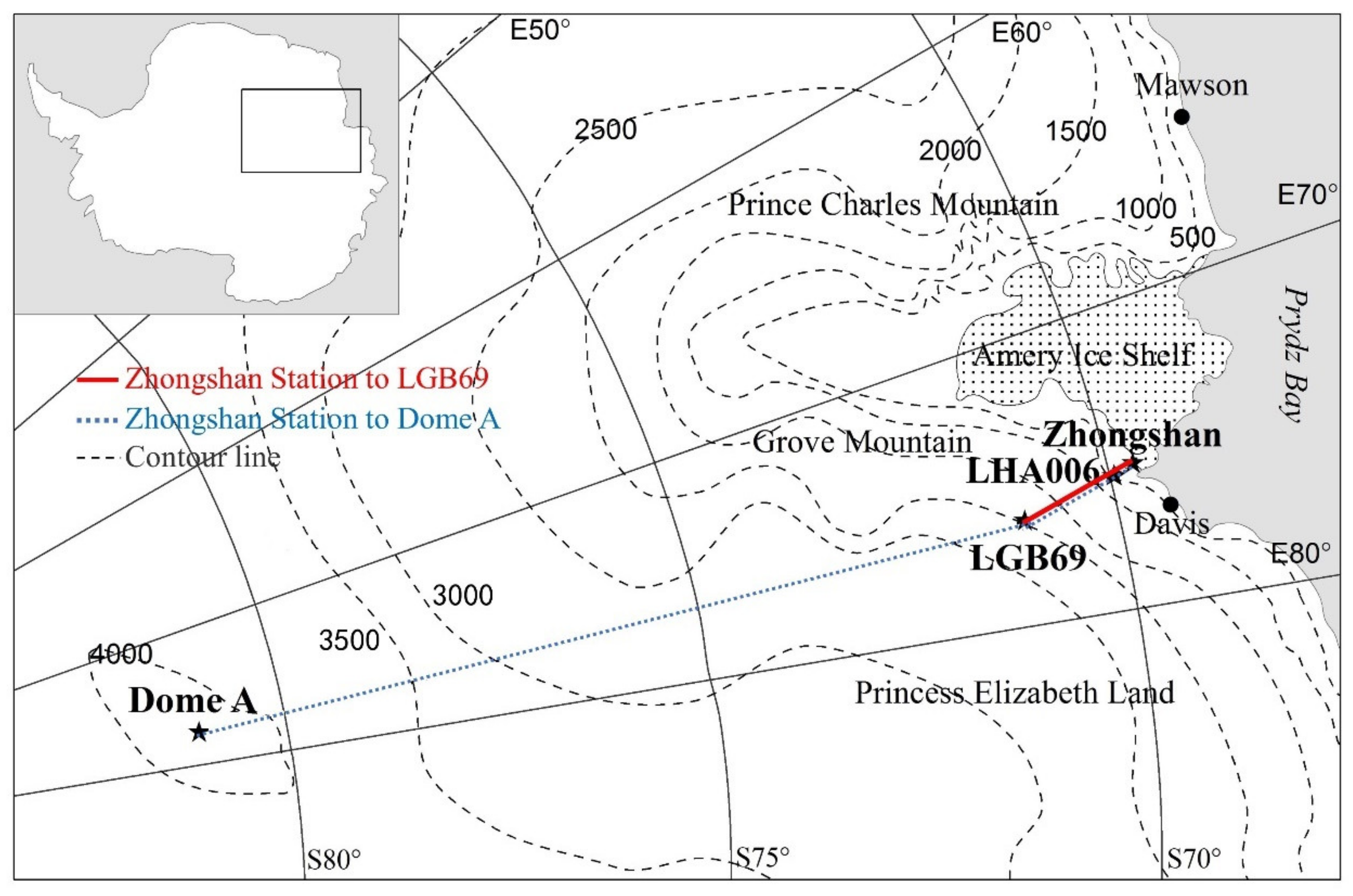
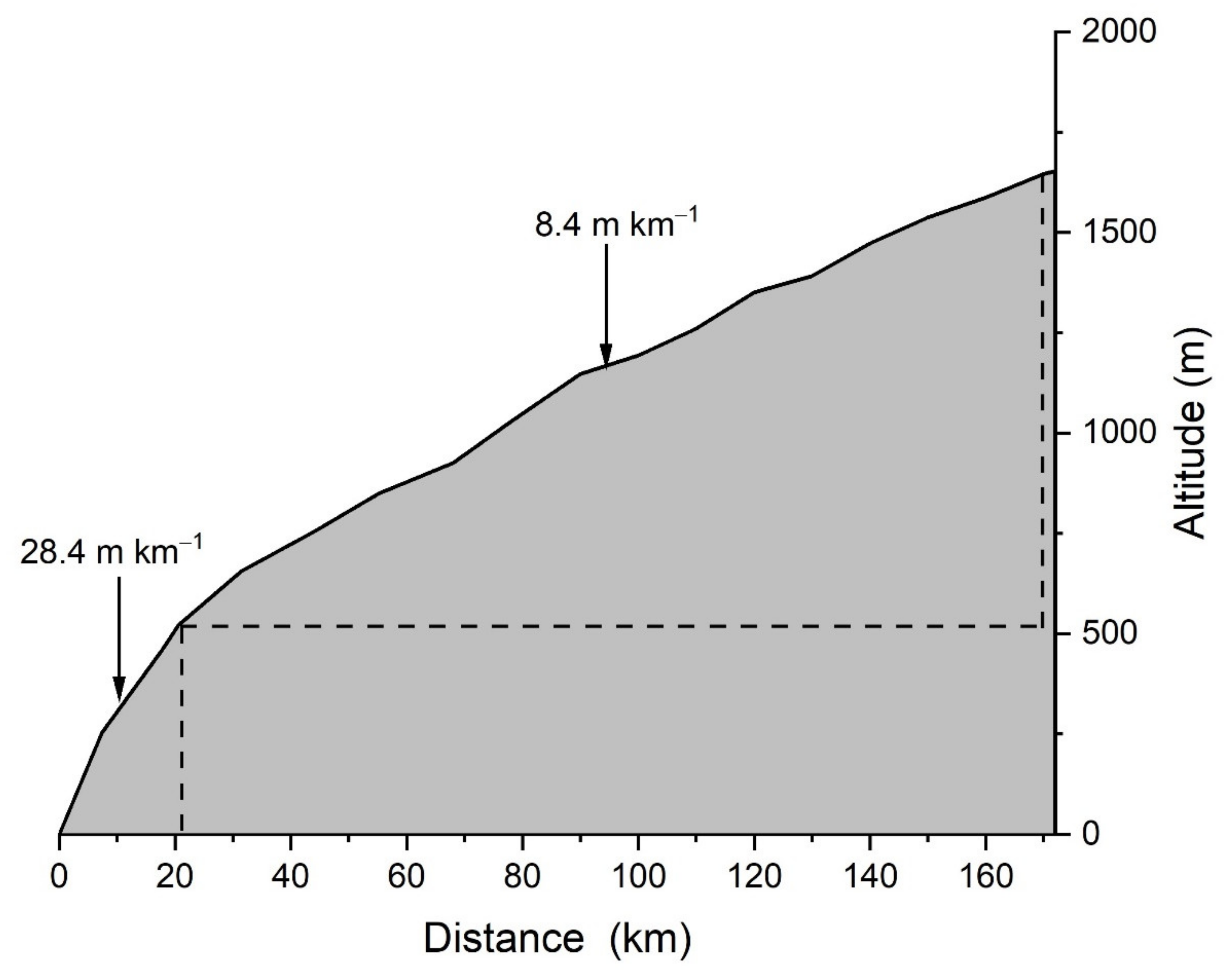
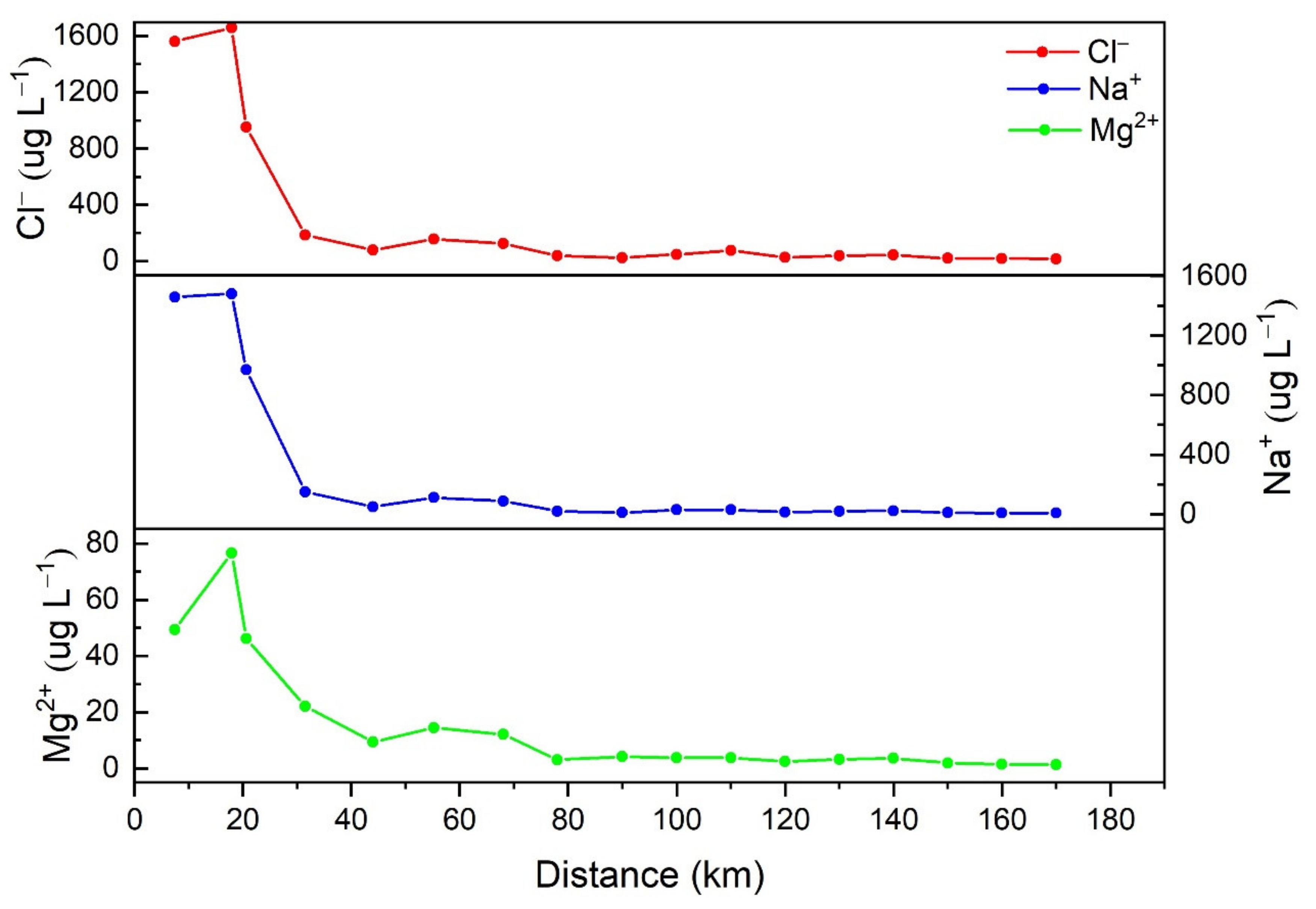
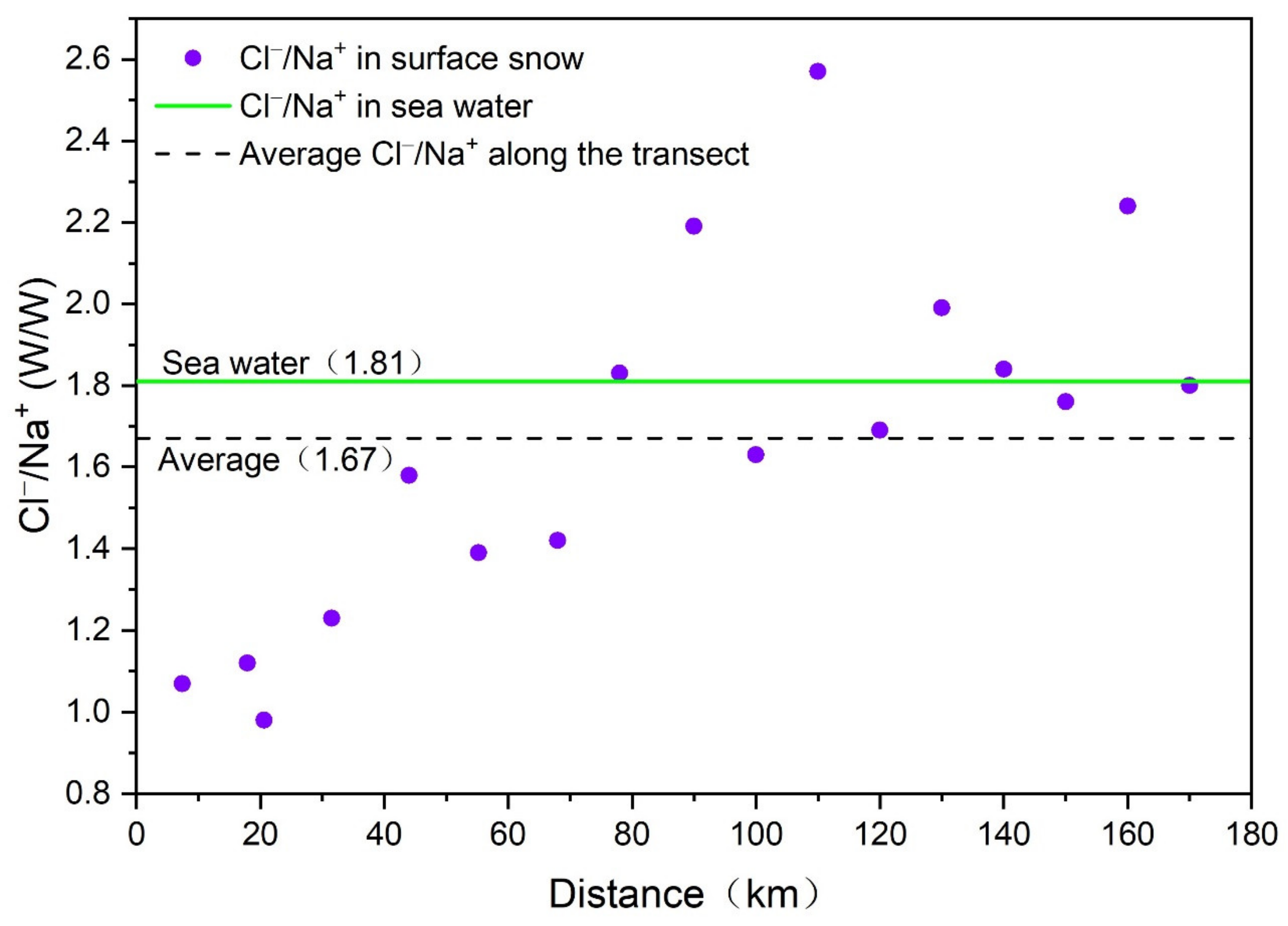
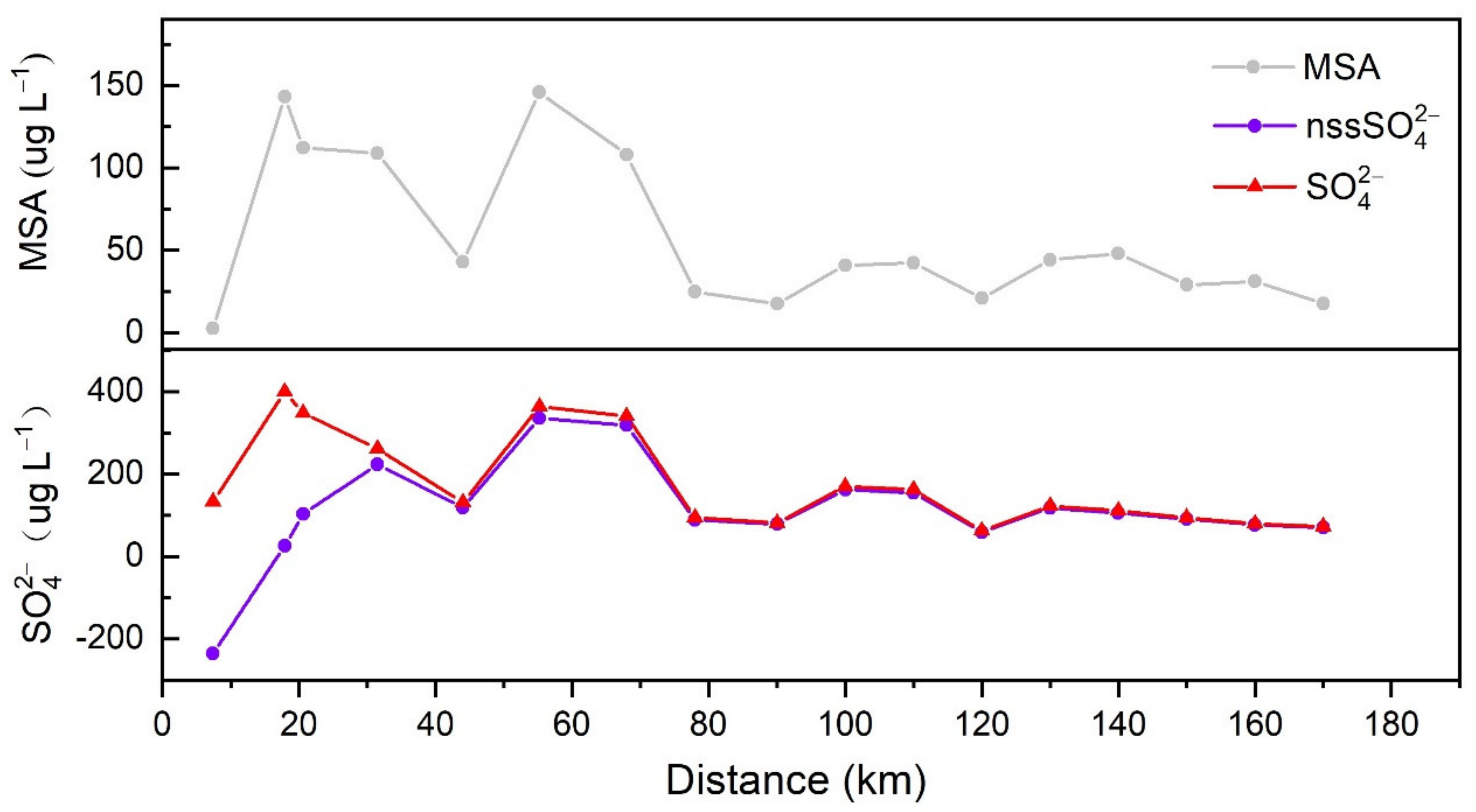
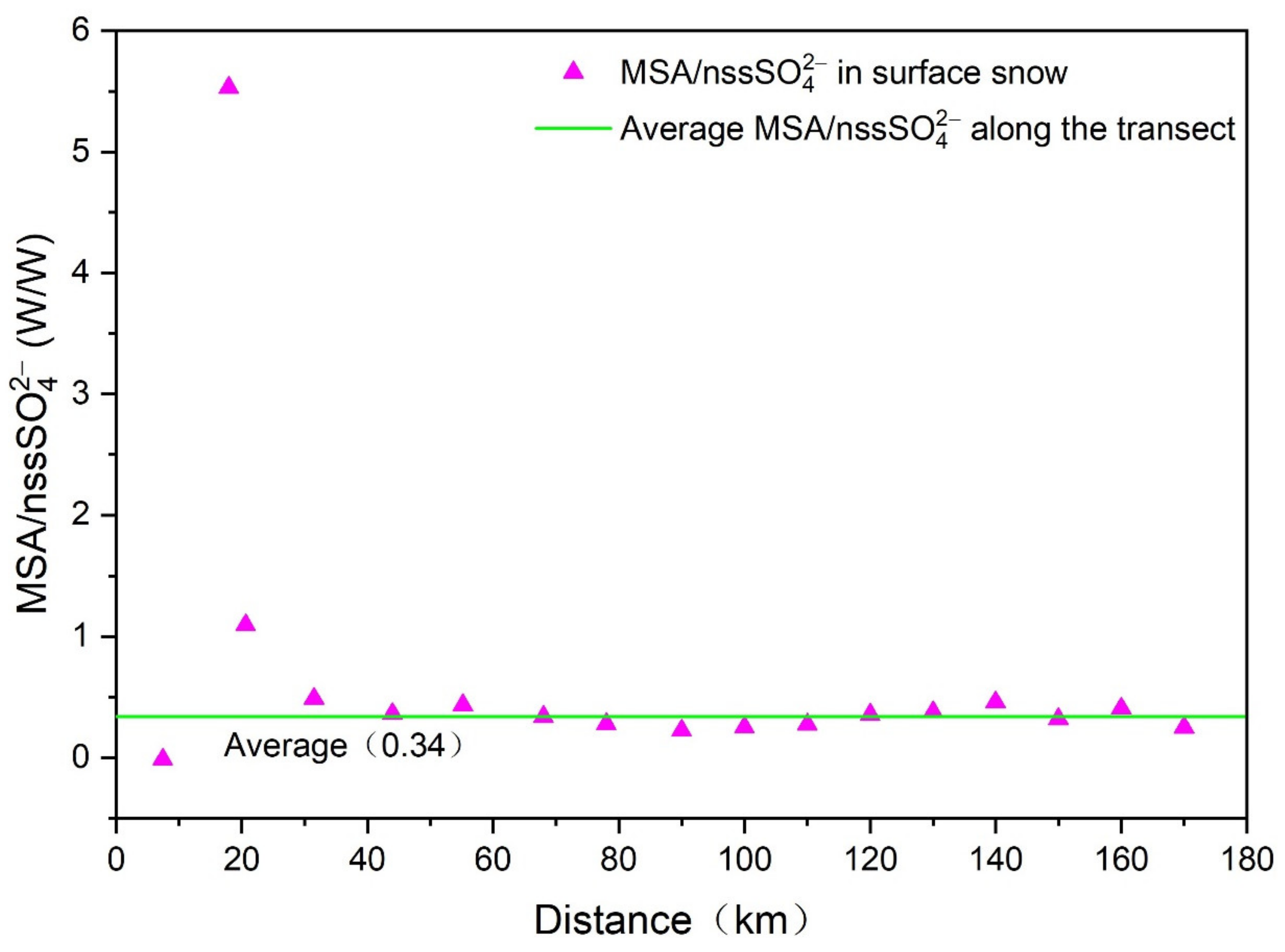
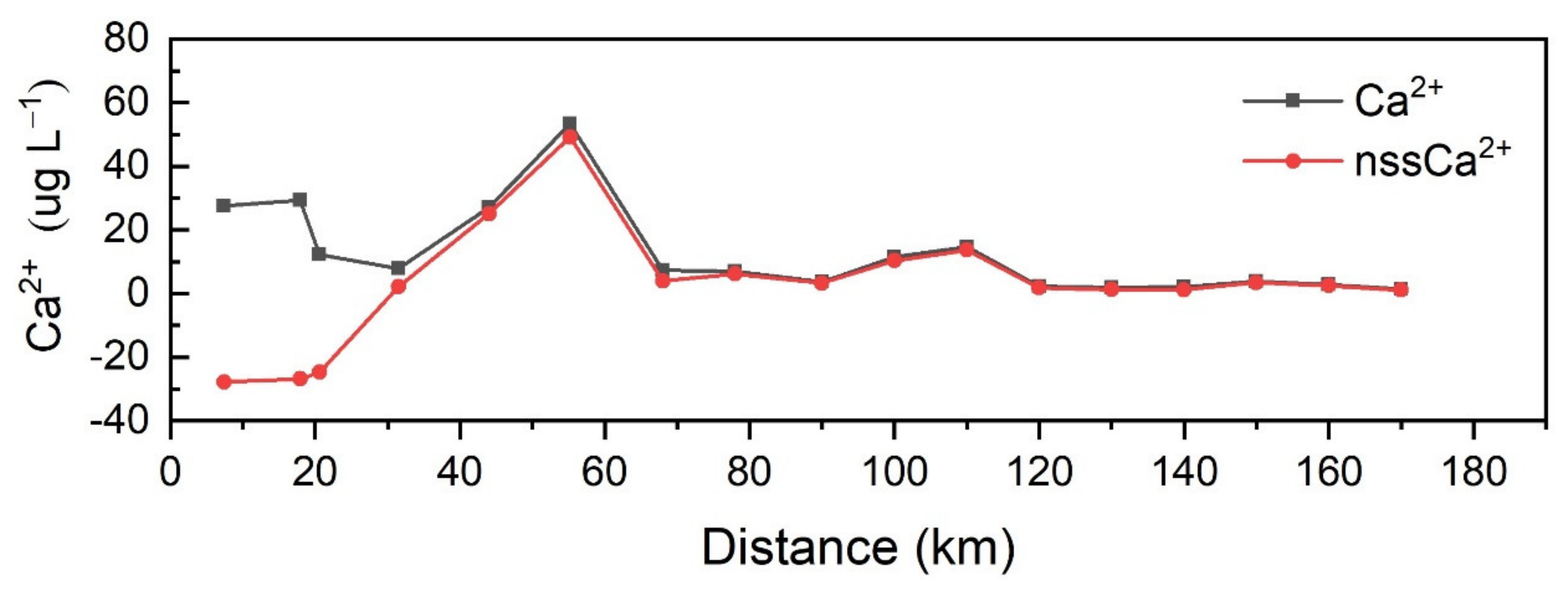

| Site | Location | Slope (m km−1) | Altitude (m) | Route Distance from Zhongshan Station (km) |
|---|---|---|---|---|
| LH9601 | 69° 26′ 01″ S 76° 20′ 00″ E | 38.5 | 285 | 7.4 |
| LHA006 | 69°31′13.6″ S 76° 17′ 36″ E | 22.4 | 520 | 17.9 |
| L156 | 69° 33′ 57.2″ S 76° 16′ 05.7″ E | 24.4 | 586 | 20.6 |
| LH404 | 69° 36′ 32″ S 76° 25′ 15.3″ E | 13.9 | 737 | 31.5 |
| LH397 | 69° 42′37.3″ S 76° 28′ 29.6″ E | 9.0 | 849 | 44.0 |
| LH386 | 69° 48′ 30.8″ S 76° 28′ 41.7″ E | 9.5 | 955 | 55.2 |
| LGB72 | 69° 55′ 16.9″ S 76° 29′ 22.7″ E | 6.7 | 1041 | 68.0 |
| LT987 | 70° 00′ 31.5″ S 76° 32′ 03.5″ E | 11.6 | 1157 | 78.0 |
| LT981 | 70° 06′ 52″ S 76° 35′ 33″ E | 11.1 | 1290 | 90.0 |
| LT976 | 70° 12′ 00.6″ S 76° 38′ 14″ E | 5.3 | 1343 | 100.0 |
| LT971 | 70° 17′ 29.3″ S 76° 41′ 57″ E | 7.4 | 1417 | 110.0 |
| LT966 | 70° 22′ 52″ S 76° 45′ 11″ E | 10.3 | 1520 | 120.0 |
| LT961 | 70° 28′ 07″ S 76° 47′ 51.5″ E | 4.5 | 1565 | 130.0 |
| LT956 | 70° 33′23.4″ S 76° 51′ 15.2″ E | 9.2 | 1657 | 140.0 |
| LT951 | 70° 38′ 37.7″ S 76° 55′ 24″ E | 7.2 | 1729 | 150.0 |
| LT946 | 70° 43′ 48.8″ S 76° 59′ 36.5″ E | 5.7 | 1786 | 160.0 |
| LT941 | 70° 49′ 02″ S 77° 03′ 40.6″ E | 6.6 | 1852 | 170.0 |
| Site | LHA006 | LGB69 |
|---|---|---|
| Depth (m) | 1.0 | 1.8 |
| Sample number | 50 | 90 |
| Altitude (m) | 520 | 1860 |
| Slope (m km−1) | 22.4 | 4.0 |
| Distance from the coast (km) | 17.9 | 172 |
| Annual accumulation rate * (kg m−2 a−1) | 200 | 255 |
| Site | Na+ | Mg2+ | Ca2+ | Cl− | MSA | SO42− | nssSO42− | nssCa2+ | δD | δ18O | d-Excess |
|---|---|---|---|---|---|---|---|---|---|---|---|
| µg L−1 | ‰ | ||||||||||
| LH9601 | 1458.92 | 49.32 | 27.63 | 1561.71 | 2.77 | 132.44 | −235.93 | −27.81 | −123.57 | −16.03 | 4.70 |
| LHA006 | 1480.13 | 76.56 | 29.42 | 1659.08 | 143.02 | 399.60 | 25.86 | −26.83 | −83.82 | −10.64 | 1.27 |
| L156 | 970.78 | 46.22 | 12.17 | 952.48 | 112.22 | 347.64 | 102.52 | −24.72 | −111.84 | −14.46 | 3.86 |
| LH404 | 150.00 | 22.05 | 7.85 | 184.64 | 108.93 | 260.93 | 223.06 | 2.15 | −128.96 | −16.43 | 2.47 |
| LH397 | 49.25 | 9.40 | 26.99 | 77.99 | 42.89 | 130.89 | 118.45 | 25.12 | −144.86 | −18.46 | 2.78 |
| LH386 | 111.62 | 14.48 | 53.40 | 155.51 | 145.82 | 363.56 | 335.38 | 49.16 | −139.09 | −16.83 | −4.47 |
| LGB72 | 88.34 | 12.07 | 7.37 | 125.56 | 108.09 | 340.76 | 318.46 | 4.02 | −154.95 | −18.99 | −3.01 |
| LT987 | 20.37 | 3.07 | 6.93 | 37.34 | 24.89 | 93.79 | 88.65 | 6.16 | −163.55 | −20.53 | 0.73 |
| LT981 | 10.88 | 4.16 | 3.66 | 23.85 | 17.67 | 80.87 | 78.12 | 3.25 | −164.42 | −20.91 | 2.83 |
| LT976 | 29.35 | 3.77 | 11.51 | 47.71 | 40.92 | 169.65 | 162.24 | 10.40 | −174.39 | −22.00 | 1.64 |
| LT971 | 29.27 | 3.82 | 14.76 | 75.36 | 42.51 | 161.71 | 154.31 | 13.64 | −169.00 | −21.58 | 3.63 |
| LT966 | 14.81 | 2.44 | 2.37 | 25.08 | 20.93 | 62.22 | 58.48 | 1.81 | −168.83 | −21.73 | 4.97 |
| LT961 | 19.51 | 3.22 | 2.01 | 38.72 | 44.25 | 122.28 | 117.35 | 1.27 | −180.78 | −22.70 | 0.78 |
| LT956 | 23.05 | 3.59 | 2.04 | 42.50 | 48.09 | 110.53 | 104.71 | 1.17 | −183.75 | −23.27 | 2.44 |
| LT951 | 10.98 | 1.89 | 3.85 | 19.36 | 29.16 | 93.99 | 91.22 | 3.44 | −184.92 | −23.32 | 1.66 |
| LT946 | 7.93 | 1.40 | 2.83 | 17.80 | 31.21 | 78.79 | 76.79 | 2.53 | −193.52 | −24.76 | 4.53 |
| LT941 | 8.13 | 1.37 | 1.44 | 14.67 | 17.60 | 72.49 | 70.43 | 1.14 | −193.06 | −24.39 | 2.04 |
| Na+ | Mg2+ | Ca2+ | Cl− | MSA | nssSO42− | δ18O | Distance | Altitude | |
|---|---|---|---|---|---|---|---|---|---|
| Na+ | 1 | 0.959 * | 0.427 | 0.998 * | 0.309 | −0.576 † | 0.789 * | −0.692 * | −0.768 * |
| Mg2+ | 1 | 0.480 | 0.963 * | 0.530 † | −0.370 | 0.900 * | −0.762 * | −0.813 * | |
| Ca2+ | 1 | 0.446 | 0.533 † | 0.106 | 0.639 * | −0.620 * | −0.619 * | ||
| Cl− | 1 | 0.320 | −0.567 † | 0.796 * | −0.693 * | −0.768 * | |||
| MSA | 1 | 0.574 † | 0.699 * | −0.533† | −0.493† | ||||
| nssSO42− | 1 | −0.067 | 0.089 | 0.188 | |||||
| δ18O | 1 | −0.929 * | −0.929 * | ||||||
| Distance | 1 | 0.991 * | |||||||
| Altitude | 1 |
| Site | Cl−/Na+ | nssSO42−/SO42− | MSA/nssSO42− | nssCa2+/Ca2+ |
|---|---|---|---|---|
| (W/W) | (%) | (W/W) | (%) | |
| LH9601 | 1.07 | −178 | −0.01 | −101 |
| LHA006 | 1.12 | 6 | 5.53 | −91 |
| L156 | 0.98 | 29 | 1.09 | −203 |
| LH404 | 1.23 | 85 | 0.49 | 27 |
| LH397 | 1.58 | 90 | 0.36 | 93 |
| LH386 | 1.39 | 92 | 0.43 | 92 |
| LGB72 | 1.42 | 93 | 0.34 | 55 |
| LT987 | 1.83 | 95 | 0.28 | 89 |
| LT981 | 2.19 | 97 | 0.23 | 89 |
| LT976 | 1.63 | 96 | 0.25 | 90 |
| LT971 | 2.57 | 95 | 0.28 | 92 |
| LT966 | 1.69 | 94 | 0.36 | 76 |
| LT961 | 1.99 | 96 | 0.38 | 63 |
| LT956 | 1.84 | 95 | 0.46 | 57 |
| LT951 | 1.76 | 97 | 0.32 | 89 |
| LT946 | 2.24 | 97 | 0.41 | 89 |
| LT941 | 1.80 | 97 | 0.25 | 79 |
| Site | LHA006 | LGB69 | ||||||
|---|---|---|---|---|---|---|---|---|
| Mean | Maximum | Minimum | σ | Mean | Maximum | Minimum | σ | |
| (µg L−1) | ||||||||
| MSA | 48.68 | 345.86 | 1.36 | 64.93 | 6.42 | 18.08 | 0.00 | 4.57 |
| Cl− | 1046.18 | 2660.70 | 262.10 | 716.06 | 66.47 | 268.10 | 5.90 | 51.22 |
| SO42− | 258.18 | 1126.74 | 121.17 | 170.50 | 38.80 | 104.08 | 11.85 | 20.84 |
| nssSO42− | 35.19 | 580.68 | −301.69 | 140.25 | 29.44 | 96.27 | 2.24 | 20.26 |
| Na+ | 883.13 | 2205.96 | 182.40 | 585.12 | 37.08 | 195.51 | 2.02 | 34.24 |
| Mg2+ | 93.07 | 223.38 | 27.66 | 58.51 | 7.25 | 28.75 | 0.53 | 6.01 |
| Ca2+ | 32.10 | 110.00 | 8.87 | 21.58 | 11.49 | 101.53 | 2.13 | 14.26 |
| nssCa2+ | −1.46 | 87.11 | −23.79 | 17.20 | 10.08 | 100.97 | 0.52 | 14.32 |
| δD | δ18O | d-Excess | Distance | Altitude | |
|---|---|---|---|---|---|
| δD | 1 | 0.997 * | −0.077 | −0.929 * | −0.933 * |
| δ18O | 1 | −0.157 | −0.929 * | −0.929 * | |
| d-excess | 1 | 0.111 | 0.064 | ||
| Distance | 1 | 0.991 * | |||
| Altitude | 1 |
| This Study | Li et al. [27] | Xiao et al. [26] | |
|---|---|---|---|
| transect | Zhongshan Station-LGB69 | Zhongshan Station-Dome A | Zhongshan Station-Dome A |
| date | 2001/2002 | 2012/2013 | 2007/2008 |
| δD-distance | −54.17‰/100 km | −18.15‰/100 km | −16.3‰/100 km |
| δD-altitude | −5.99‰/100 m | −7.14‰/100 m | −8.5‰/100 m |
| δ18O-distance | −6.84‰/100 km | −2.37‰/100 km | −2.20‰/100 km |
| δ18O- altitude | −0.75‰/100 m | −0.93‰/100 m | −1.1‰/100 m |
| d-excess-distance | 0.53‰/100 km | - | 1.31‰/100 km |
| d-excess-altitude | 0.03‰/100 m | - | 0.6‰/100 m |
| d-excess variation range | −4.47‰–4.97‰ | −3.38‰–15.12‰ | 2.47‰–39.74‰ |
| Site | LHA006 | LGB69 | ||||||
|---|---|---|---|---|---|---|---|---|
| Mean | Maximum | Minimum | σ | Mean | Maximum | Minimum | σ | |
| (‰) | ||||||||
| δD | −143.36 | −121.15 | −178.19 | 16.47 | −244.71 | −200.27 | −302.09 | 27.22 |
| δ18O | −18.33 | −15.04 | −23.26 | 2.10 | −30.91 | −25.04 | −37.96 | 3.22 |
| d-excess | 3.32 | 10.88 | −1.25 | 2.53 | 2.56 | 9.33 | −6.64 | 3.59 |
| Sample number | 49 * | 89 * | ||||||
Publisher’s Note: MDPI stays neutral with regard to jurisdictional claims in published maps and institutional affiliations. |
© 2021 by the authors. Licensee MDPI, Basel, Switzerland. This article is an open access article distributed under the terms and conditions of the Creative Commons Attribution (CC BY) license (http://creativecommons.org/licenses/by/4.0/).
Share and Cite
Huang, W.; Yan, M.; Mulvaney, R.; Qian, Z.; Liu, L.; An, C.; Xiao, C.; Zhang, Y. Spatial Variability of Glaciochemistry along a Transect from Zhongshan Station to LGB69, Antarctica. Atmosphere 2021, 12, 393. https://doi.org/10.3390/atmos12030393
Huang W, Yan M, Mulvaney R, Qian Z, Liu L, An C, Xiao C, Zhang Y. Spatial Variability of Glaciochemistry along a Transect from Zhongshan Station to LGB69, Antarctica. Atmosphere. 2021; 12(3):393. https://doi.org/10.3390/atmos12030393
Chicago/Turabian StyleHuang, Weilong, Ming Yan, Robert Mulvaney, Zuoqin Qian, Leibao Liu, Chunlei An, Cunde Xiao, and Yujia Zhang. 2021. "Spatial Variability of Glaciochemistry along a Transect from Zhongshan Station to LGB69, Antarctica" Atmosphere 12, no. 3: 393. https://doi.org/10.3390/atmos12030393






